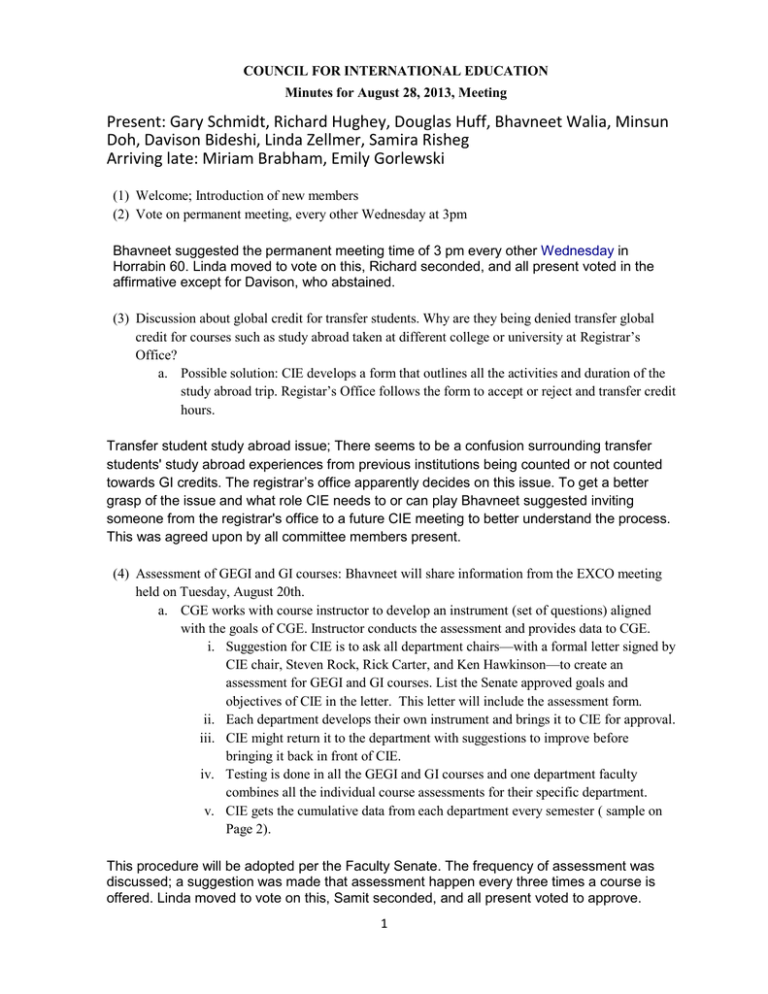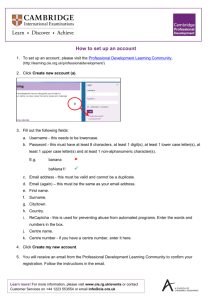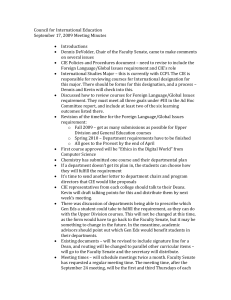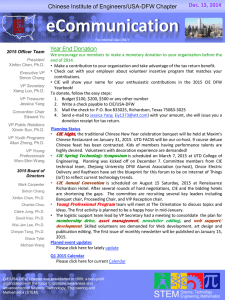Present: Gary Schmidt, Richard Hughey, Douglas Huff, Bhavneet Walia, Minsun
advertisement

COUNCIL FOR INTERNATIONAL EDUCATION Minutes for August 28, 2013, Meeting Present: Gary Schmidt, Richard Hughey, Douglas Huff, Bhavneet Walia, Minsun Doh, Davison Bideshi, Linda Zellmer, Samira Risheg Arriving late: Miriam Brabham, Emily Gorlewski (1) Welcome; Introduction of new members (2) Vote on permanent meeting, every other Wednesday at 3pm Bhavneet suggested the permanent meeting time of 3 pm every other Wednesday in Horrabin 60. Linda moved to vote on this, Richard seconded, and all present voted in the affirmative except for Davison, who abstained. (3) Discussion about global credit for transfer students. Why are they being denied transfer global credit for courses such as study abroad taken at different college or university at Registrar’s Office? a. Possible solution: CIE develops a form that outlines all the activities and duration of the study abroad trip. Registar’s Office follows the form to accept or reject and transfer credit hours. Transfer student study abroad issue; There seems to be a confusion surrounding transfer students' study abroad experiences from previous institutions being counted or not counted towards GI credits. The registrar’s office apparently decides on this issue. To get a better grasp of the issue and what role CIE needs to or can play Bhavneet suggested inviting someone from the registrar's office to a future CIE meeting to better understand the process. This was agreed upon by all committee members present. (4) Assessment of GEGI and GI courses: Bhavneet will share information from the EXCO meeting held on Tuesday, August 20th. a. CGE works with course instructor to develop an instrument (set of questions) aligned with the goals of CGE. Instructor conducts the assessment and provides data to CGE. i. Suggestion for CIE is to ask all department chairs—with a formal letter signed by CIE chair, Steven Rock, Rick Carter, and Ken Hawkinson—to create an assessment for GEGI and GI courses. List the Senate approved goals and objectives of CIE in the letter. This letter will include the assessment form. ii. Each department develops their own instrument and brings it to CIE for approval. iii. CIE might return it to the department with suggestions to improve before bringing it back in front of CIE. iv. Testing is done in all the GEGI and GI courses and one department faculty combines all the individual course assessments for their specific department. v. CIE gets the cumulative data from each department every semester ( sample on Page 2). This procedure will be adopted per the Faculty Senate. The frequency of assessment was discussed; a suggestion was made that assessment happen every three times a course is offered. Linda moved to vote on this, Samit seconded, and all present voted to approve. 1 b. For pre-approved courses: The way CGE reviews previously approved courses is to pick a certain category and review all the courses under it. CIE could use this method to start reviewing previously approved courses. c. Another suggestion was to hold workshops and ask for participation of all faculty teaching global courses. WID does these workshops for courses which fulfill WID requirement. Emily volunteered to facilitate and develop this workshop. Bhavneet moved to vote on developing this workshop, Richard seconded, and all present voted in the affirmative, except Davison and Samira, who abstained. A suggestion was made to ask Michael Stryker, former Chair of CIE, to co-facilitate. Emily will contact Michael about this. Bhavneet moved to adjourn, Samit seconded, and all present voted in favor. Respectfully submitted, Emily Gorlewski (with help from Samit Chakravorti for the first part of the meeting) 2 SAMPLE General Education Assessment COURSE: PROFESSOR: SECTION: TERM: CRITICAL THINKING # of Student Responses in Category (1) # of Student Responses in Category (2) # of Student Responses in Category (3) # of Student Responses in Category (4) Critical Thinking Rubric BEST (1) Student’s response addresses primary question. Additionally, student demonstrates superb critical thinking by recognizing the imbedded complexities inherent in the primary question. (2) Student’s response addresses primary question; however, student’s answer does not explore additional complexities and issues related to the primary question. (3) Student’s response contains numerous content errors that hinder critical thinking; however, student’s response attempts critical thinking process. WORST (4) Critical thinking is not displayed in student’s response. WRITING # of Student Responses in Category (1) # of Student Responses in Category (2) # of Student Responses in Category (3) # of Student Responses in Category (4) Writing Rubric BEST (1) Student’s response contains no major errors and only some minor errors. General construction (i.e., structure, organization, persuasiveness, etc.) is superb. Student clearly thought out answer. (2) Student’s response contains no major errors and only some minor errors. General construction (i.e., structure, organization, persuasiveness, etc.) is satisfactory. (3) Student’s response contains numerous minor errors and/or some major errors, yet the reader is able to comprehend the idea(s) that the student conveys. (aka, “not gibberish”) WORST (4) Student’s response contains many major errors that results in an incomprehensible and unintelligible answer. (aka, “gibberish”) 3



